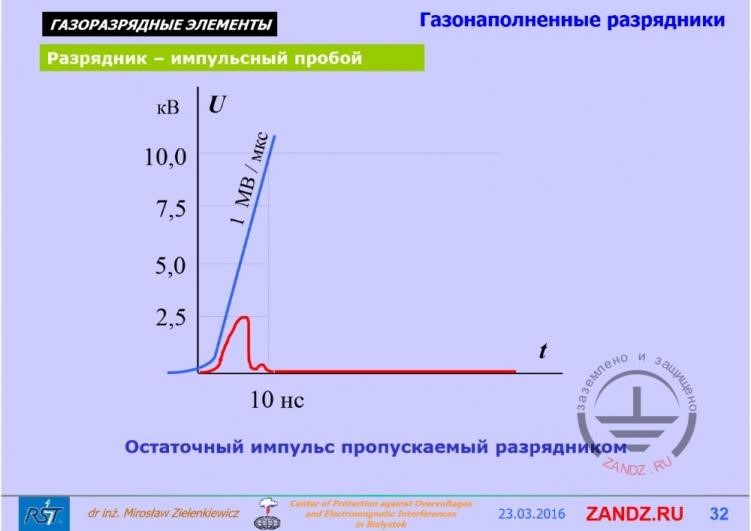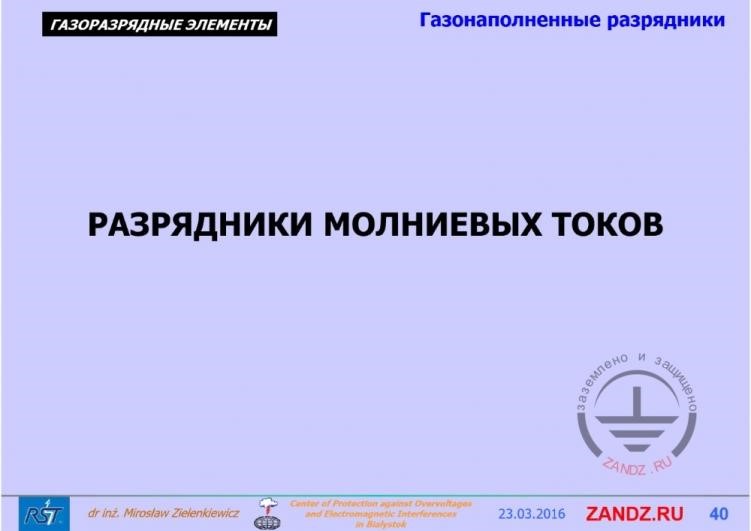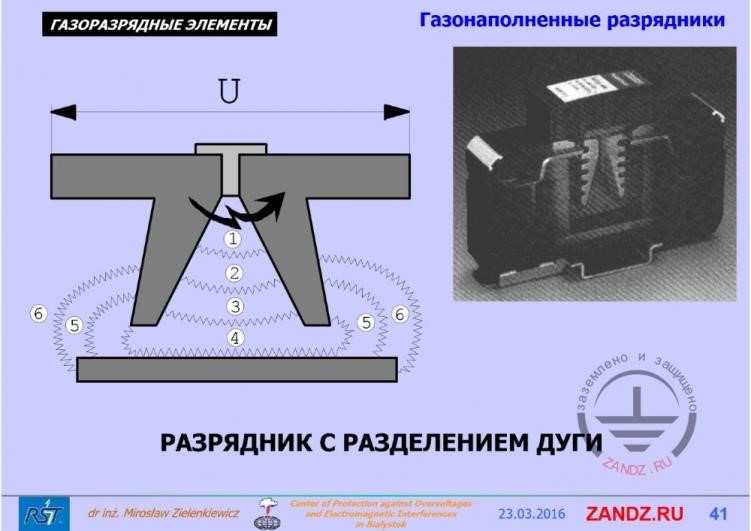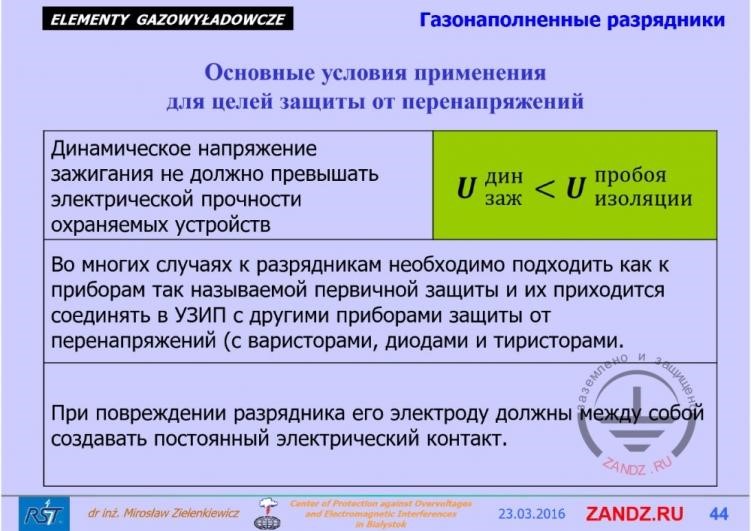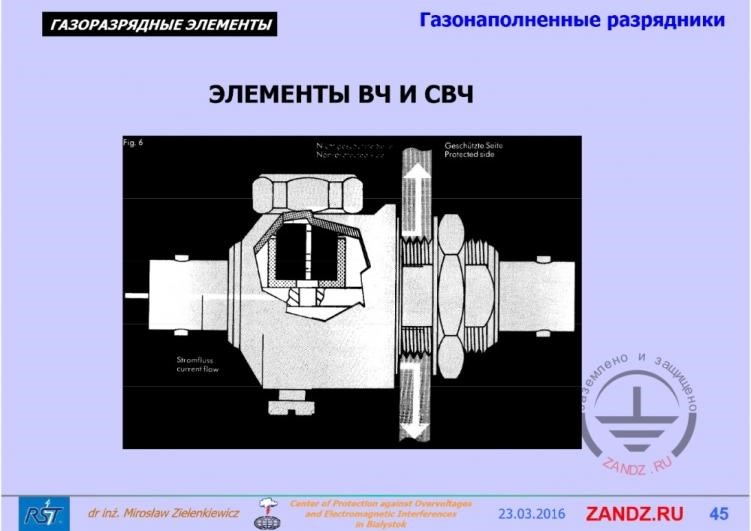The second Webinar from the series "Surge protection"
Webinar text. Page 3
Quick navigation through slides:
<< Page 1:
1. Surge protection for power lines 230/400 V 50 Hz Part 1
2. About Miroslav Zelenkevich
3. Main circuit of enabling surge protection elements
4. Cascade protection circuit
5. SPD – the main protection circuit
6. Gas-discharge and semi-conductor devices
7. Spark air gap
8. Forms of gas-filled electrodes
9. Picture of two electrodes
10. Picture of railway line
11. Spark arresters of old type
12. Coal arresters
13. Why coal
14. customer line connection circuit
15. Coal arresters’ operation principle
<< Page 2:
16. Protection of pole-mounted transformer substation
17. Gas arresters of 6 kV line
18. Construction of gas arresters
19. Additional protection element
20. Characteristics of protection element
21. Advantages of gas discharge elements
22. Gas filled arresters
23. Railway arresters
24. Construction of gas filled arresters
25. Gas filled arresters of minor energy
26. Cross section of an arrester
27. Arrester in direct current circuit
28. Arrester in alternate current circuit
29. Sine-wave voltage impact on an arrester
30. Arrester - pulse dialling
Page 3:
31. Residual pulse, missed by the arrester
32. Maximal voltage value
33. Discharge action steps at the protection of a device
34. The main parameters of arresters Part 1
35. The main parameters of arresters Part 2
36. The main parameters of arresters Part 3
37. Advantages of gas-filled arresters in low-frequency circuits
38. Example of electrical parameters of a 3- electrode arrester
39. Disadvantages of arresters in low-frequency circuits
40. Lightning current arresters
41. Arresters with arc division
42. Approximate parameters of arresters
43. Main application conditions for surge protection purposes
44. Dynamic pick-up voltage
45. HF and SHF elements
Page 4:>>
46. Semi-conductor surge protection elements
47. Variable resistors
48. Characteristics of U-I variable resistor
49. Structure of ZnO – variable resistor
50. Sizes of ZnO – variable resistor
51. Mono-crystal lattice
52. Three areas of volt-ampere characteristics
53. Advantages and disadvantages of ZnO variable resistors
54. Parameters of variable resistors Part 1
55. Parameters of variable resistors. Part 2
56. How to choose a variable resistor correctly?
57. Protective diodes.Types
58. Protective diode on an example of TRANSIL device structure
59. Designed diodes
60. Response characteristics
Page 5:>>
61. Types of protective diodes by the execution method
62. Advantages of protective diodes
63. Disadvantages of protective diodes
64. Protective diode operation stages
65. Protected device surge resistivity
66. Detector input circuit protection
67. Line repeater of phone line communication protection
68. All-round choice
69. Special purposes in surge protection of circuits
70. Low-voltage electricity supply surge protection
71. Arrester’s connection circuit in a construction project
72. Steppable cascade
73. Electricity supply network surge protection
74. Dynamic pickup voltage
75. Questions and answers
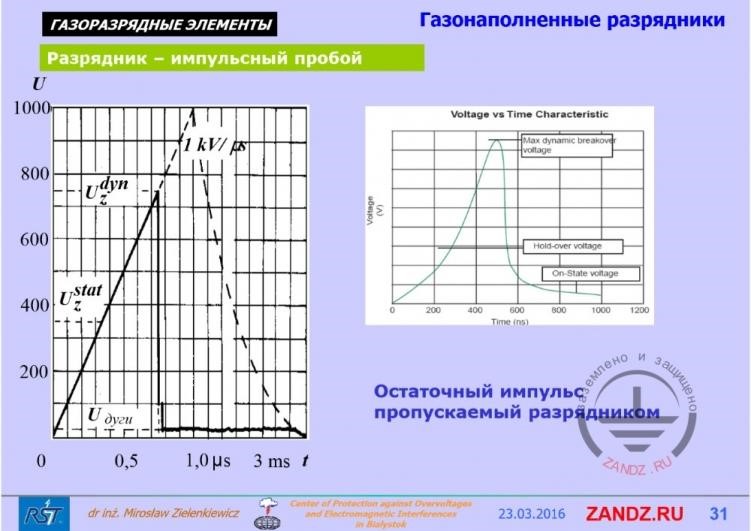
Residual impulse missed by the arrester
Газоразрядные элементы- Gas discharge elements
Газонаполненные разрядники – gas filled dischargers
Разрядник – импульсный пробой – arrester – pulse puncture
Остаточный импульс пропускаемый разрядником – residual pulse missed by the discharger
- Here we see such an example, where the pulse growing with the speed of 1 kV/ms is given. Its dynamic ignition voltage is about 750 V, if we look at these characteristics, given. And for this element, the static ignition voltage was 400 V, that is in practice after the response of invent, the energy going under this curve comes into our protected device. On the right we see characteristics for a small arrester, indicating nano-second time, from another catalogue. That is, the influence impulse is much quicker and we also see that such a pin achieves our devices, brings quite big certain energy, which is significant for arresters and may bring harm to our electronics.
Газоразрядные элементы- Gas discharge elements
Газонаполненные разрядники – gas filled dischargers
Разрядник – импульсный пробой – arrester – pulse puncture
Остаточный импульс пропускаемый разрядником – residual pulse missed by the discharger
- This slide indicates, that even with nano-second pulses, we see that there appears some pin, which brings energy to our devices. But it turns out, that it is often a big problem, because in this case, the max voltage value for this pulse is 2,5 kV, which may mean that our element won't stand such energy.
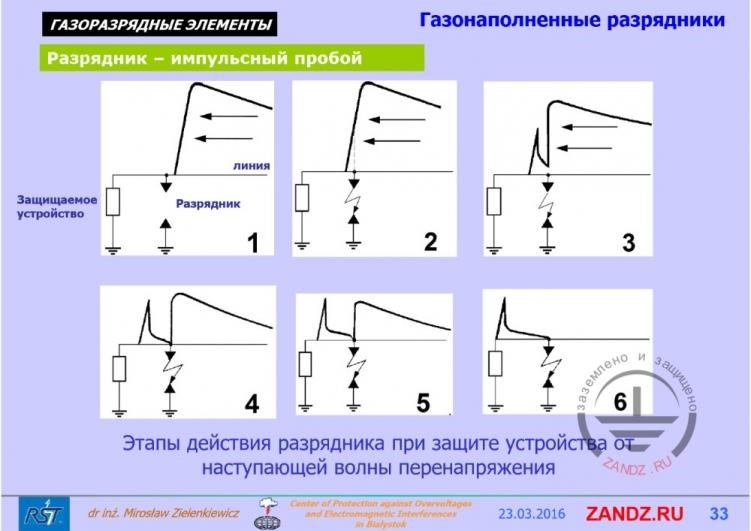
Arrester's operation stages at the device protection
Газоразрядные элементы- Gas discharge elements
Газонаполненные разрядники – gas filled dischargers
Разрядник – импульсный пробой – arrester – pulse puncture
Защищаемое устройство – protected device
Линия - line
Разрядник - discharger
Этапы действия разрядника при защите устройства от наступающей волны перенапряжения – Stages of discharger’s action when protecting the device from the coming overvoltage wave
- If we thoroughly see how such a system operates, we will see that if the overvoltage wave comes to our arrester, it is going on the right line at the moment. On the right slide we see, that at the certain moment, after the exceeding of arresters response voltage, it is enabled and a certain fragment of this overvoltage energy comes to our load, which is on the left of the protected. Its main part flows to the ground, but part of certain energy gets on our devices. We have to deal with this energy the way that it won't be higher than the resistance of our protected equipment or too high and we should additionally restrict it.
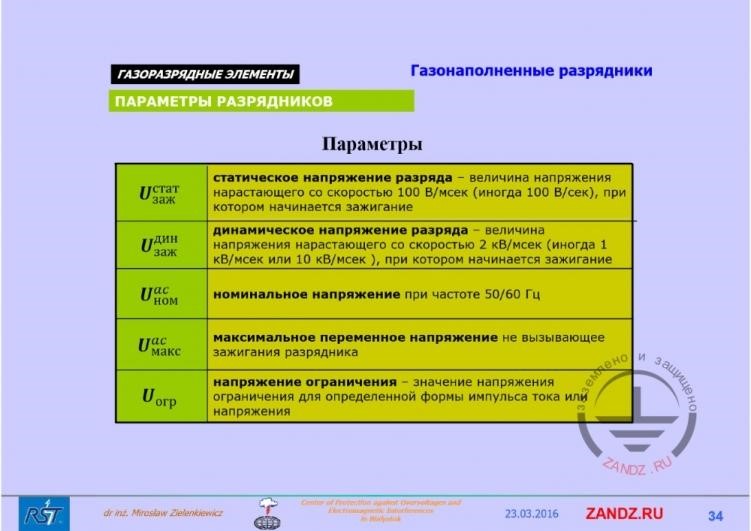
Main parameters of arresters. Part 1
Газоразрядные элементы- Gas discharge elements
Газонаполненные разрядники – gas filled dischargers
Параметры разрядников- parameters of arresters
Параметры - parameters
Статическое…Static charge voltage – value of the voltage growing with the speed of 100 V/ms (sometimes 100 V/s) at which the ignition starts
Динамическое… - Dynamic charge voltage – value of the voltage growing with the speed of 2 kV/ms (sometimes 1 kV/ms or 10 kV/ms) at which the ignition starts
Номинальное… nominal voltage at the frequency of 50/60 Hz
Максимальное…- maximal alternating voltage not causing discharger’s ignition
Напряжение ограничения – clamping voltage – value of the clamping voltage for a certain current or voltage pulse form
-Let's look at such main parameters of an arrester which should help the designer when choosing it. The first element is static response voltage, I call it ignition. It is obligatory for comparison of different arresters. This value is defined at the growing speed of 100V/ms. It helps us to define these devices and for constant current, which happens rarely, or simply to compare for the choice of the starting element, to determine its parameters. From the point of view of life, we need dynamic parameters, for example, dynamic ignition, as you already know, it is several times higher, than static response voltage and it is defined for the speed of pulse growing. Nominal voltage at the alternate current is very important and it should be determined by the parameters.
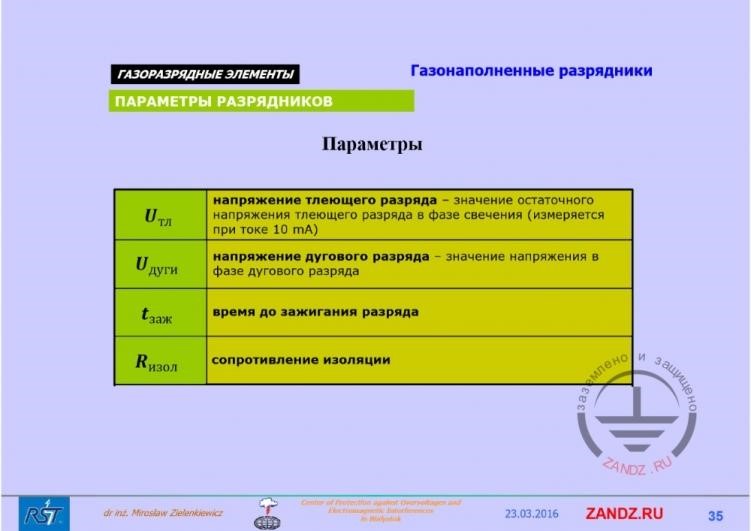
Main parameters of arresters. Part 2
Газоразрядные элементы- Gas discharge elements
Газонаполненные разрядники – gas filled dischargers
Параметры разрядников- parameters of arresters
Параметры - parameters
Напряжение тлеющего разряда – glow charge voltage – value of the residual voltage of the glowing charge in the glow phase (measured at the current of 10 mA)
Напряжение дугового разряда- voltage value in the arc discharge phase
Время до зажигания разряда – time to discharge ignition
Сопротивление изоляции – insulation resistance
- But for our knowledge, about what we've said, the information about glow voltage is very useful. It is obvious, that this is voltage of about 20-30 V and for all of us, it restricts the application zone of these devices by voltage. Arc voltage as additional parameter. Time till charge ignition, the so-called response time. By the way, there are certain technical problems with response time. I won't raise this topic here, we can agree that this is simply temporary ignition, it will be enough. In case of arresters - it is from half microsecond to one microsecond. And insulation resistance is a very crucial parameter for us on practice, because if we measure this resistance during operation, when we suspect that the element is spoiled, we can determine its efficiency as very high, when the element is not spoiled.
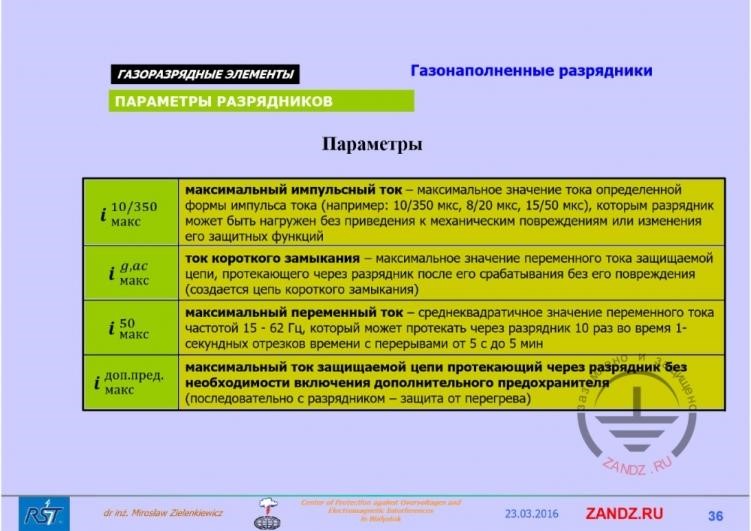
Main parameters of arresters. Part 3
Газоразрядные элементы- Gas discharge elements
Газонаполненные разрядники – gas filled dischargers
Параметры разрядников- parameters of arresters
Параметры - parameters
Максимальный импульсный ток – maximal pulse current- maximal value of current of a certain form of current pulse (for example 10/350 ms, 8/20 ms, 15/50 ms) by which the arrester can be overloaded without bringing to mechanic destructions or change of its protective functions
Ток короткого замыкания – short circuit current – maximal value of the alternating current of the protected circuit, flowing through the arrester after its activation without damaging it (short circuit is formed)
Максимальный переменный ток – maximal alternating current – meansquare value of alternating current with the frequency of 15-62 Hz, which may flow through the arrester 10 times during 1 second time intervals with the pauses from 5 seconds to 5 minutes
Максимальный ток защищаемой цепи…- - maximal current of the protected circuit flowing through the discharger without the need of enabling of additional fuse (sequentially with the discharger– overheating protection)
- And such parameters as maximal current appear in the catalogues and this current should be defined for a certain form of pulse, as it is indicated here. Here we see other forms that can be met. This is the current which can load an arrester without mechanical damage or without modification of its protective functions. Additional parameter that appears, let's see, but we won't discuss everything here. It is maximal current of the protected circuit, it appears in the electric supply network, which flows through the arrester without the need to connect additional fuse. It means that after enabling our arrester, if we expect that the short circuit current will exceed the capability of our arrester to sustain it. After the arrester we should enable an additional fuse, it will protect it from overheating. We will surely talk about it later.
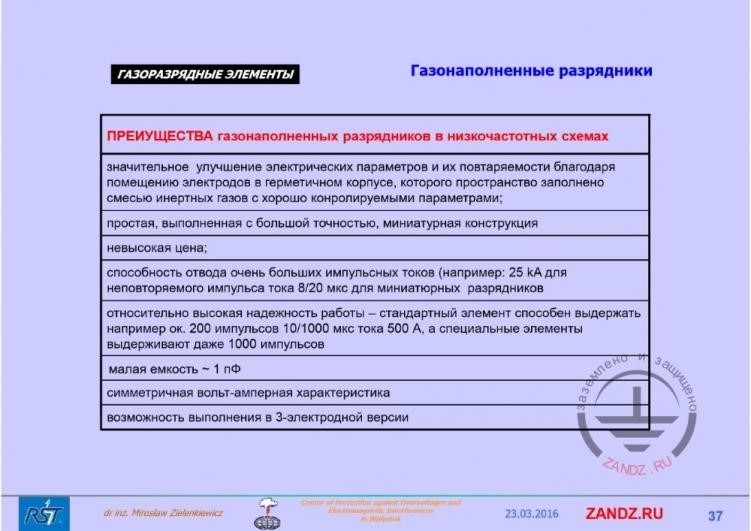
Advantages of gas-filled arresters in low-frequency circuits
Газоразрядные элементы- Gas discharge elements
Газонаполненные разрядники – gas filled dischargers
Advantages of gas-filled dischargers in low-frequency circuits
- significant improvement of electrical parameters and their repetition thanks to placing of the electrodes in a hermetic case, the space of which is filled with the mixture of inert gases with well-controlled parameters;
- simple miniature construction performed with a great accuracy
-low price
- ability to drain very large pulse currents (for example: 25 kA for a non-repeated current pulse 8/20 ms for miniature dischargers
-relatively high work reliability – standard element is able to stand about 200 pulses 10/1000 ms of 500 A current and special elements stand even 1000 pulses
- low capacity ~ 1pF
Symmetric volt-ampere characteristics
Possibility to perform in a 3-electrode version
-Let's look at the main parameters of gas-filled arresters which we should know. These advantages, significant improvement of these parameters and repetition thanks to placing the electrodes in a hermetical case, the space of which is filled with the mixture of inert gases with well-controlled parameters. A simple but made with high precision tiny construction is very important here. Low price of these gas-filled tiny arresters and capability to drain very high pulse currents, for example, 25 kA for a non-repeated current pulse 8/20 ms for tiny arresters. Relative high operation reliability, because such a standard element is able to stand about 200 pulses of current 10/1000 ms. It is used in the States.
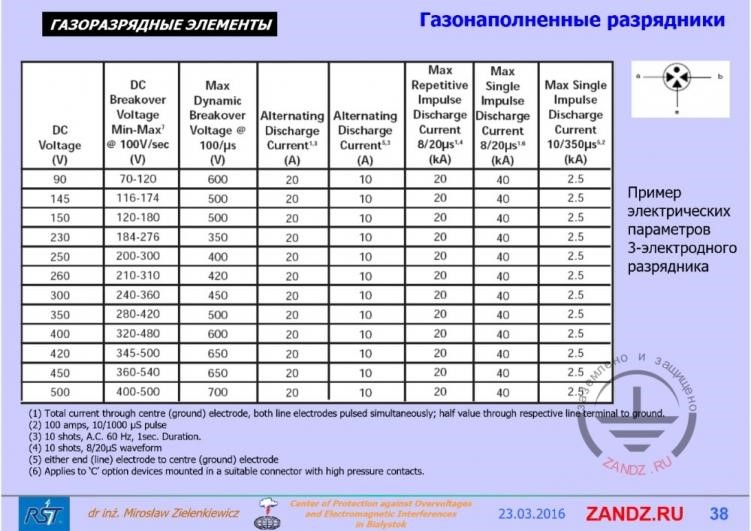
Example of electric parameters of 3-electrode arrester
Газоразрядные элементы- Gas discharge elements
Газонаполненные разрядники – gas filled dischargers
Пример электрических параметров 3-электродного разрядника – example of electric parameters of a 3-electrode discharger
- If we look at the parameters indicated in the catalogues, we will see that today such small gas-filled arresters achieve quite high currents, which they are not able to drain. Please look, I repeat the pulse - it is about 20 kA, 8/20 ms and one-time maximal pulse -it's even 40 kA. It means, that such an element is able to drain quite high energy, and we really need it, as the first cascade element of the multi-cascade protective SPD.
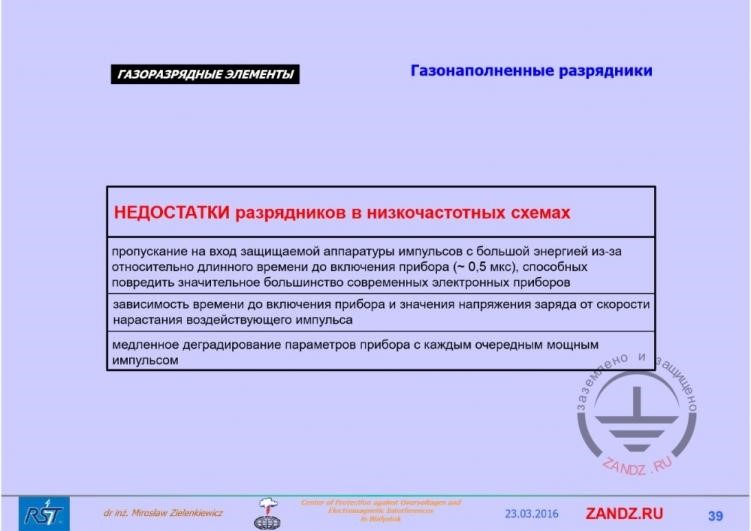
Disadvantages of arresters in low-frequency circuits
Газоразрядные элементы- Gas discharge elements
Газонаполненные разрядники – gas filled dischargers
Disadvantages of dischargers in low-frequency circuits
- missing of great energy pulses at the input of the protected equipment due to a relatively long time before the activation of the device (~0,5 ms), able to damage the significant majority of modern electronic devices
- dependence of time before activation of a device and charge voltage value on the affecting pulse growth speed
- slow downgrading of the device parameters with every powerful pulse
- The disadvantages are quite serious in such an element. That is, first of all, such an element passes pulses of greater energy to the protected equipment, as its response time is about 0,5 ms. These pulses are able to bring harm to the majority of modern electric devices. Dependence of response time of this element depends on the value of charge voltage and growing speed of the influencing impulse. And such an element as low degraded parameters with every powerful pulse. Here we deal with the picking up of particles from electrodes' metal, which start to flow around in the interelectrode space. They settle on the walls, ceramic walls, insulating from the atmosphere air, and they simply reduce the route, reducing the response voltage.
Газоразрядные элементы- Gas discharge elements
Газонаполненные разрядники – gas filled dischargers
Разрядники молниевых токов – lightning current dischargers
- Slightly different parameters are characteristic for lightning currents' arresters, which are used by electric supply networks.
Газоразрядные элементы- Gas discharge elements
Газонаполненные разрядники – gas filled dischargers
Разрядник с разделением дуги – arrester with arc division
- Here we see an example of such element; it is simpler for explanation that is why I indicated it. On the next webinar we will talk about elements, another element is much better the best characteristics. But here it is good to talk about physics of such event, for what this element was invented. But, as I've said before, the main problem in case of arresters at the appearing of overvoltages in the circuits, is low voltage of arc current. And if this element is not able to extinguish the arc, it may ignite. And here lies the big practical problem on the market, because very few manufacturers can produce such devices, and those who cannot, try to convince everybody, that variable resistor elements are also good in such conditions. Unfortunately, the practice doesn't confirm this, because variable resistor elements, as a rule, stand pulses of 8/20 ms, but do not stand partial current pulses of 10/350 ms. And it initiates not very fair competition on this market. We will surely talk about it later. I can only tell, that in our schemes, which we have been designing for 20 years, we only use gas-filled elements of electric supply network, which we put on the input of all cables of electric supply into the object on the border of zone 0A and 0B and zone 1 and such elements are able to work long and efficiently.
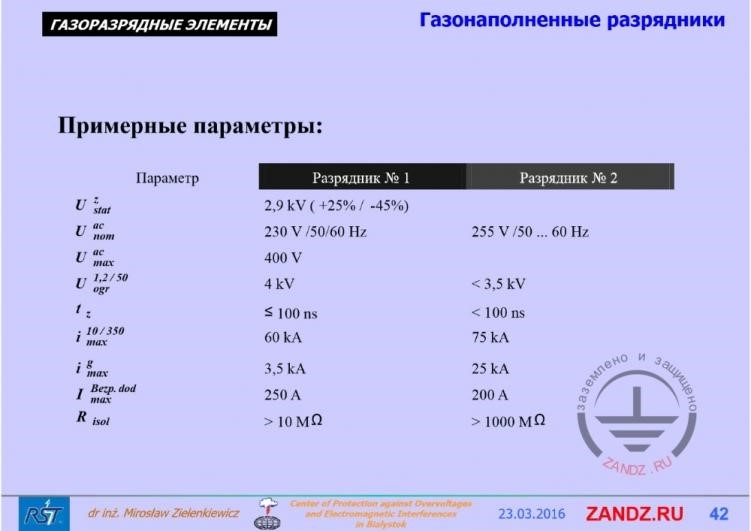
Approximate parameters of arresters
Газоразрядные элементы- Gas discharge elements
Газонаполненные разрядники – gas filled dischargers
Примерные параметры – Approximate parameters
Параметр - parameter
Разрядник - discharger
-Let's look at the parameters which are indicated by the manufacturer. Sorry, these parameters are in Polish, but I think they are clear, because it is a technical device. I compare two arresters, where we should always be guided by the current. That is, when we define what we protect ourselves from, we should remember, that lightning current is a huge current by the standard for the first protection category 200 kA, if we consider in our calculations, that 100 kA current can flow into the object. It means, for three cores, for three phases in the system, where we have an additional conductor, we divide this current into three and we get the value of 33 1/3 kA. Then we select the element with the greater current and we see that in that case I indicated at the element, for example 60 kA or 75 kA. Look, that restriction voltage of this element at the pulse impact 1,2/50 ms, won't exceed 4 kV with one element, and 3,5 kV with another. See what parameters, one indicates the voltage of the static discharge, and the second doesn't indicate at all. But we see that there is quite a big variation in parameters. This is characteristic for charges in gas and in addition let's see what is interesting in practice - additional fuse current. For the first case 250 A, for the second case 200 A. It means, that such an element doesn't stand discharge currents, if there is a fuse before it in the power cable, the parameters of which exceed this current. In this case, we have to consequently connect an additional fuse to our arresters but we will discuss this method later.
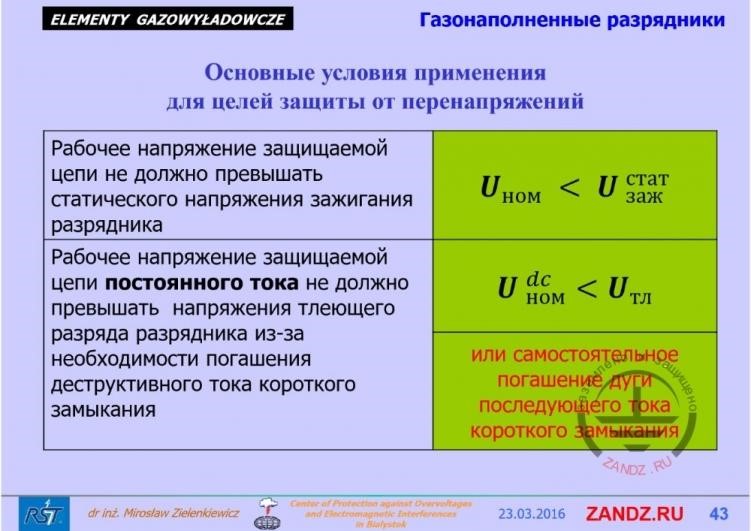
The main use conditions for surge protection purposes
Газоразрядные элементы- Gas discharge elements
Газонаполненные разрядники – gas filled dischargers
Основные условия применения для целей защиты от перенапряжений – main conditions of using for surge protection purposes
Рабочее напряжение…. – working voltage of the protected circuit should not exceed static voltage of the discharger’s ignition
Working voltage of the protected DC circuit should not exceed the voltage of the discharger’s glow discharge due to the need to blow-out the destructive short circuit current
Или самостоятельное – or self-facilitated arc suppression of the follow short circuit current
- Then, if we summarize knowledge about this moment, we see that the main conditions of using for surge protection purposes are, firstly - the nominal voltage should be less than static voltage of arrester ignition. Working voltage of the protected DC circuit should not exceed the glow discharge voltage due to the need to extinguish the destructive short circuit current. Or this element should extinguish the arc of the next short circuit current itself, which will always appear when our element activates in electric supply network. I think it is obvious for everybody, and then we simply close the transformer clamp for the time of response moment when there is a surge.
Газонаполненные разрядники – gas filled dischargers
Основные условия применения для целей защиты от перенапряжений – main conditions of using for surge protection purposes
Dynamic ignition voltage should not exceed electric strength of the protected devices
In many cases, it is necessary to treat dischargers as devices of the so-called primary protection and they should be connected with other surge protection devices into SPD (variable resistors, diodes and thyristors)
At the damage of the discharger, its electrodes must create a constant electric contact between each other.
- Dynamic response voltage of such an element should not exceed electric strength of protected devices - it is protective function. That is, we need to protect our insulation, including our element, not vice versa. Insulation cannot protect our protective element. In many cases, the approach to the arresters should be the same as to the devices of the so-called primary protection and they must be connected with SPDs of other surge protection devices - variable resistors, diodes, four-layer switches.
Газоразрядные элементы- Gas discharge elements
Газонаполненные разрядники – gas filled dischargers
Элементы ВЧ и СВЧ – HF and SHF elements
- In the elements, in high frequency and super high frequency there necessarily are such arresters. They are very useful there, because due to the minor capacity, the frequency of working elements is bordering - it is about 1 Hz. It is crucial and it is better to know about it. Today we won't talk about it anymore, if we have time at the seminars about protective elements, we will talk about it.
Do you have any questions left? Send them to our technicians and you will receive detailed and reasoned answers.
<< Previous Page
Slides from 16 to 30
Next Page >>
Slides 46 to 60
Useful materials for designers:
- Webinars with the leading industry experts
- Everything for the calculation of grounding and lightning protection
- Useful materials: articles, recommendations, examples
Related Articles:


